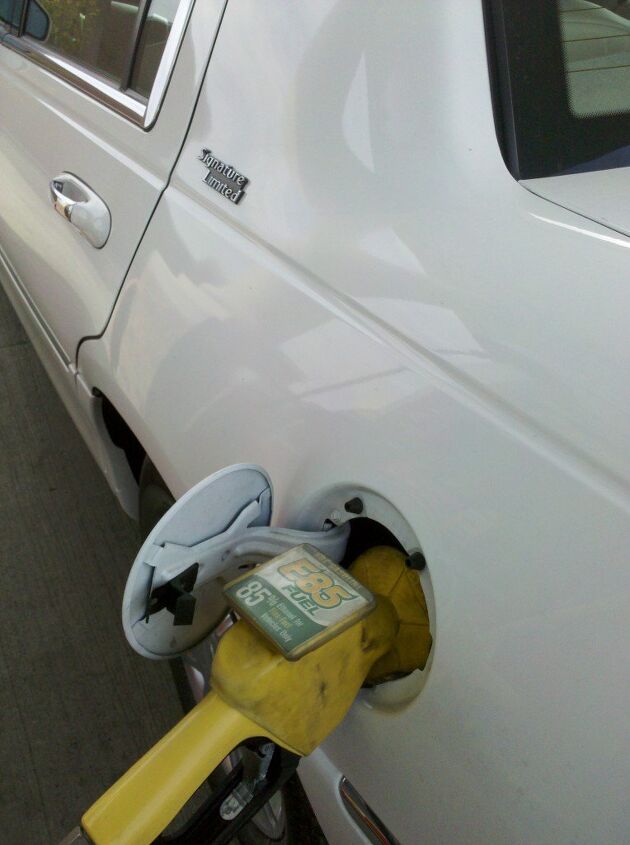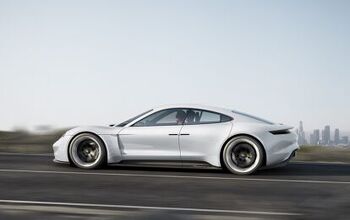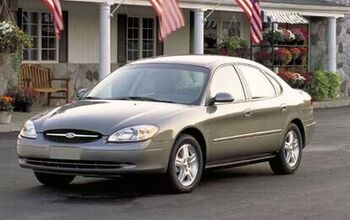Take A Chance On E(85)

You’ve heard the old joke about ham and eggs, right? The chicken is involved, and the pig is committed? Well, I’m going to give ethanol a shot for a while and report the details to all of you. I’m involved, and my Town Car is committed.
There are three E85 stations within five miles of my house. Two of them are operated by the Kroger grocery chain. E85 pricing is perhaps the one thing in America more subject to political and economic meddling than gasoline pricing, but it’s currently at a point where it could make sense to run it.
To find out for myself, I’ve run my 2009 Lincoln Town Car Signature Limited down to below “E” and refueled with E85. On October 24, 2010, E85 was priced at $2.29 locally for me, compared to $2.79 for 87 octane gas. My Town Car reports 21.4 miles per gallon in mixed-use driving, usually running between 75 and 85 on the freeway and with about five surface street miles for every fifteen ones on the Interstate.
I estimate that I need to average 17.8 mpg in order for E85 to “balance out” under these conditions. I’m scheduled to drive about 600 miles in the next seven days, so on Monday I will come back and tell you how I did.
No, this isn’t particularly scientific, and it ignores the other potential costs of E85 — wear on the engine, fuel system damage, food prices in Zimbabwe, and so on — but it’s a start.

More by Jack Baruth


































Comments
Join the conversation
Growing up on a farm, I never would have believed something as boring as corn would become such a hot cultural subject. The reason why so much more corn is grown in America compared to the rest of the world is because corn is a native crop. It was the most important staple for all agricultural Native American societies for thousands of years. It has remained the staple crop of the America's from Canada to Peru. In addition it grows well in nearly all parts of the U.S, often without the need of irrigation (like here in Michigan). There is nothing unnatural or unhealthy about eating corn. However when we take our corn and turn nearly all of it into red-meat and sugar, that is unhealthy. No one is recommending the all red-meat and sugar diet, regardless of what plant the sugar comes from. In regards to antibiotics in cows, its not that the corn itself is somehow poisoning or infecting the cows. Its the fact that a cow's digestive system isn't set up to digest hard dense grains like corn, its meant to digest grasses (like corn silage, and hay) the corn irritates and inflames the rumen, leading to infection, leading to the use of antibiotics. The fact is we have the potential and infrastructure to grow a virtually unlimited supply of this valuable crop. So, if stuffing it into cows, and then stuffing it into ourselves in the form of .99 cent double cheese burgers isn't a healthy idea, maybe pumping it into our cars is. Or we could just cut back on the sugar and beef and eat allot more tortillas and corn flakes.
Politics and economics aside, the technology for FFVs is really cool. As I understand it, there's an infrared spectrometer built into the fuel lines that tells the ECU exactly what the composition of the fuel is, and the ECU adjusts accordingly.
I wouldn't object if all cars that ran on "gasoline" were fully FFV and could run on any of the alkanes or alcohols. It costs about $100/car for the technology and would create a market for butanol and methanol besides ethanol.
NP: Greetings From Asbury Park - BS
The woman strokes his polished chrome.
On most Ford FFVs you will see a 12-13% loss in MPG on true E85. However in Oct in most parts of the country we are on the "winter blend" which is actually E70 even if the pump is still labeled E85, though you may be getting the "transition blend" of E74. On the winter or transition blend you should see a slightly smaller loss in MPG. Either way you will notice a bump in HP and more so TQ. The ulitimate blend however is in the E40-E50 range. In my FFV MPG actually improves 12-13% over gas. It will also yield even larger power increases.
My 220,000 mile '99 Plymouth Voyager has the 3.3 flex-fuel engine (R-code), and it states on the label inside the filler door that E85 is OK to use. I wouldn't mind trying it, but would it be a good idea this late in the van's life? Also, it has had an engine swap, and all I know is that it came from another van of similar vintage. Does the engine itself matter, or is it the peripherals that make it an FFV?